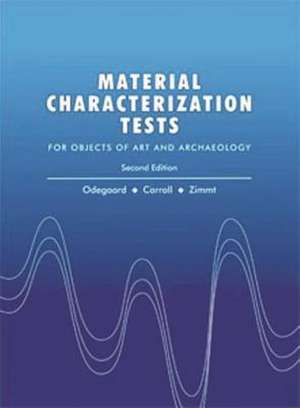Material Characterization Tests: For Objects of Art and Archaeology
Autor Nancy Odegaard, Scott Carroll, Werner S. Zimmten Limba Engleză Paperback – 9 iul 2015
Preț: 373.26 lei
Nou
71.42€ • 74.57$ • 59.11£
Carte indisponibilă temporar
Specificații
ISBN-10: 1909492205
Pagini: 242
Greutate: 0.73 kg
Ediția:Revised
Editura: Archetype Publications
Descriere
The first edition of this book was welcomed not only by the conservation profession but also by those working in archaeology and museums who need to know from what materials objects are made, the compounds that are associated with them or the characteristics of the materials used to package or store them. This second edition (reprint) includes modifications to several of the procedures described - tests for metals, inorganic compounds, organic and synthetic materials as well as several tests that help to characterize materials. The tests are applicable to a wide range of object classes including metal, textile, leather, paper, plastics and architectural materials. In addition to presenting the detailed methodology for carrying out each test, the authors have evaluated the effectiveness of each test in order to assist the reader in selecting the most applicable test and interpreting the results.
Cuprins
Foreword for UK readers
Acknowledgements
Introduction
Chemical safety
Scientific method and techniques of spot testing
Spot tests for metals
Test for aluminium ions using aluminon (aurintricarboxylic acid)
Test for aluminium metal using Alizarin Red S and electrolysis
Test for antimony using spot-test papers
Test for arsenic compounds using spot-test papers
Test for arsenic or phosphorus in copper metal using iron(III) chloride
Test for chromium using diphenylcarbazide and electrolysis
Test for copper using spot-test papers
Test for copper using nitric acid and ammonia
Test for copper using potassium ferrocyanide
Test for copper using rubeanic acid
Test to determinate gold karat using a touchstone
Test to determinate gold quality using nitric acid
Test for gold using tin (II) chloride and electrolysis
Test for gold plating using aqua regia
Test for iron using potassium ferrocyanide
Test for iron using hydrochloric acid
Test for lead using spot-test papers
Test for lead using potassium iodide and electrolysis
Test for lead using potassium dichromate
Test for mercury salts using diphenylcarbazone
Test for mercury using aqua regia
Test for mercury-cinnabar using a melting point apparatus
Test for nickel using spot-test papers
Test for nickel using dimethylglyoxime
Test for silver using potassium dichromate
Test for silver using potassium dichromate and electrolysis
Test to determine silver quality using nitric acid
Test for tin using cacotheline using electrolysis
Test for tin using sulfurous acid
Test for zinc using ammonium mercuric thiocyanate
Test for zinc in copper alloy using electrolysis
Test for zinc using spot-test papers
Spot tests for inorganic and ionic materials
Test for calcium using nitric acid and sulfuric acid
Test for carbonate using hydrochloric acid and barium hydroxide
Test for chloride ions using sulfuric acid
Test for halogens (chlorine) using pyrolysis (Beilstein test)
Test for chloride using silver nitrate
Test for chlorine in polymers using pH paper and pyrolysis
Test for nitrate using spot-test papers
Test for nitrate using iron(II) sulfate
Test for phosphate using spot-test papers
Test for phosphate using ammonium molybdate and benzidine
Test for phosphate using ammonium molybdate and ascorbic acid
Test for sulfate using spot-test papers
Test for sulfate using barium chloride
Spot tests for organic materials
Test for starch using iodine/potassium iodide
Test for simple carbohydrates using o-toluidine
Test for complex carbohydrates using o-toluidine
Test for carbohydrates using triphenyltetrazolium chloride
Test for triglycerides using triglyceride reagent
Test for unsaturated oils using potassium permanganate
Test for blood using benzidine
Test for protein (nitrogen) using calcium oxide and pyrolysis
Test for protein using copper(II) sulfate (Biuret test)
Test for sulfur using lead acetate paper and pyrolysis
Test for organic sulfur using calcium oxalate and pyrolysis
Test for phenols in vegetable-tanned leather using lead acetate
Test to determine vegetable-tanned leather using iron(III) sulfate
Test for indigo using sodium hydrogen sulfite
Test for lignin using phloroglucinol
Test for rosin using sulfuric acid (Raspail test)
Test for cellulose using aniline acetate and pyrolysis
Test for cellulose and its derivatives using 1-naphthol (Molisch test)
Test for nitrate (cellulose nitrate) using diphenylamine
Test for poly(vinyl alcohol) using iodine/potassium iodide
Test for polyester groups using hydroxylamine hydrochloride
Test for polyamides using p-dimethylaminobenzaldehyde
Test for polycarbonates using p-dimethylaminobenzaldehyde
Test for silicone-based rubber using pyrolysis
Other tests
Test of pH using an Insta-Check(R) pH pencil
Test for acidity with pH pens
Test for volatile acids with pH papers and lime water
Test for volatile acides with pH papers and glycerol
Test for acidic vapors using cresol red
Test for hardness with a pencil sequence
Test to determine specific gravity using an electronic analytical balance
Test for radioactivity using photographic film
Appendix 1: Dilution table and chemical concentration calculations
Appendix 2: Explanation of pH
Appendix 3: List of abbreviations
Appendix 4: Table of reagents with safety information used in spot tests
Appendix 5: Chemicals, equipment and supplies
Appendix 6: Product suppliers
Appendix 7: Materials Characterization Trial Form
Appendix 8: Glossary
Appendix 9: Bibliography
The first edition of this book was welcomed not only by the conservation profession but also by those working in archaeology and museums who need to know from what materials objects are made, the compounds that are associated with them or the characteristics of the materials used to package or store them.
